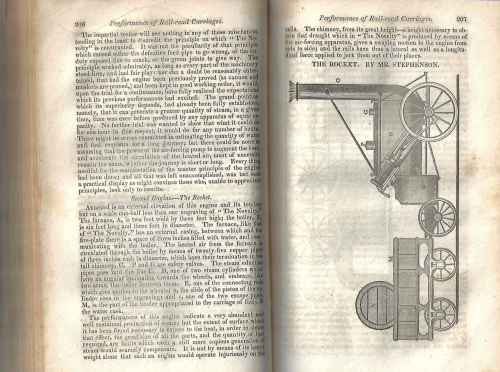 Journal of the Franklin Institute, Philadelphia, 1830; volume 5 (new series) and volume 9 overall, with text illustrations and five plates. Half-calf, with raised bands. Ex-library, with some scuffing on the spine; also a few stamps on the title page, and a library card pocket at the rear endpaper. Very Good copy. $225
Journal of the Franklin Institute, Philadelphia, 1830; volume 5 (new series) and volume 9 overall, with text illustrations and five plates. Half-calf, with raised bands. Ex-library, with some scuffing on the spine; also a few stamps on the title page, and a library card pocket at the rear endpaper. Very Good copy. $225
This volumes includes many articles of interest, including a longish early article on railroads:
“Account of the Performance of Various Rail-road Carriages on the Liverpool and Manchester Rail-road”, pp 186-210 and pp 257-267; featuring nearly full-page illustrations of (William) Stephenson's “The Rocket”, “Novelty No. 1” of Braithwaite & Ericsson (along with a schematic for “Novelty No 2”, and the Sans Pareil”. Note: “The Rocket” was designed by Stephenson only a year earlier, the very early locomotive appearing in 1829 (in England). The “Sans Pareil” was design by Timothy Hackworth and was first presented in that same year of 1829.
Also the following railroad papers:
“On the Power required to Propel Carriages on Rail-roads, compared with that for moving boats in Canals”, pp 140-141;
“Modes of Adopting Rail-way Cars to Roads &c.” pp 151-154;
“Remarks on the Pendulous Rail-road Car, and on the adapting Railway Cars to run on common roads”, pp 237-239;
Also:
Walter Johnson, “On the Relation between Rolling and Dragging Friction”, pp 57-69;
This piece is followed by the first in what was intended to be a series by the editor called “Modern Antiques”, (pp 69-70)where the journal would “furnish, occasionally, some palpable evidences of the forestalling disposition of remote answers…who have deprived us….off the honor of being the true and original inventors, or discoverers, of various improvements in mechanics, and other useful arts; and who even peep from their graves to dispute the rights of those who have issued to the world their new born projects in the forms of letter patents…”
And:
“On the Preparation of Crayons, or Pastels”, pp 94-99; ;
[Henry M. Western], “Specification of a Patent for a Tide Power...for the Purpose of Applying Power to Machinery...”, pp 154-155;




Comments